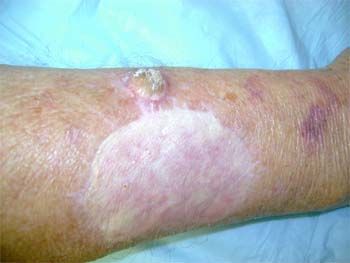Squamous Cell Carcinoma in a Renal Transplant Recipient
In this transplant recipient, the real question is whether this squamous cell carcinoma is a recurrence of the prior one or a new primary neoplasm.

A squamous cell carcinoma developed on the arm of this 58-year-old renal transplant recipient. The lesion was subject to a wide local excision, and the defect closed with a split-thickness skin graft. Fourteen months later, the patient now presents with a hard nodule immediately adjacent to the prior surgical site.
Key point: The most likely diagnosis is squamous cell carcinoma. The central keratin-filled crater is typical for keratoacanthoma subtype of squamous cell carcinoma. The real question is whether this lesion is a recurrence of the prior one or a new primary neoplasm.
Treatment: This lesion must be considered high risk because of the proximity to a preceding cancer of the same type and equally because of the patient’s chronic, ongoing immunosuppression related to organ transplant. Moh micrographic surgery was used to excise the lesion. This technique allows the clinician to trace out the tumor, ensuring that it is completely removed.
Note: This transplant patient has clearly demonstrated the propensity to develop potentially lethal skin cancers. He should be given anti-tumor prophylaxis, such as an oral retinoid (isotretinoin or acitretin), and strongly cautioned to exercise strict sun avoidance.